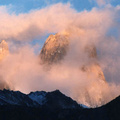Home / 1998.02 South America / Argentina / Fitz Roy 5
After several hundred kilometers long bus trip we arrived to a small village - El Chalten, close to Chile-Argentina Patagonian border.
The legendary peaks of the Torre Mountain and the Fitz Roy Mountain stand out in the middle of the flat Patagonian steppe and attract numerous climbing expeditions from all over the world. The road from El Calafate ends in the Park, in El Chalten, name the Indians gave to the Fitz Roy Mountain. From El Chalten, one of the most popular walks is the one that leads to the first camping site of the Torre Mountain. From here, it is possible to admire the walls of this granite mountain that during many decades was considered "impossible to climb", until it was conquered for the first time by the expedition headed by Cesare Maestri in 1970. The Tehuelches, primitive inhabitants of the regions, venerated the Fitz Roy Mountain and named it "Chalten", which means "mountain that sends out smoke", since they believed it was a volcano, because its summit is always covered with a layer of clouds. Its special shape and height must have served them as an orientation signal during their annual migrations from the Atlantic Ocean to the Andes.
The legendary peaks of the Torre Mountain and the Fitz Roy Mountain stand out in the middle of the flat Patagonian steppe and attract numerous climbing expeditions from all over the world. The road from El Calafate ends in the Park, in El Chalten, name the Indians gave to the Fitz Roy Mountain. From El Chalten, one of the most popular walks is the one that leads to the first camping site of the Torre Mountain. From here, it is possible to admire the walls of this granite mountain that during many decades was considered "impossible to climb", until it was conquered for the first time by the expedition headed by Cesare Maestri in 1970. The Tehuelches, primitive inhabitants of the regions, venerated the Fitz Roy Mountain and named it "Chalten", which means "mountain that sends out smoke", since they believed it was a volcano, because its summit is always covered with a layer of clouds. Its special shape and height must have served them as an orientation signal during their annual migrations from the Atlantic Ocean to the Andes.





